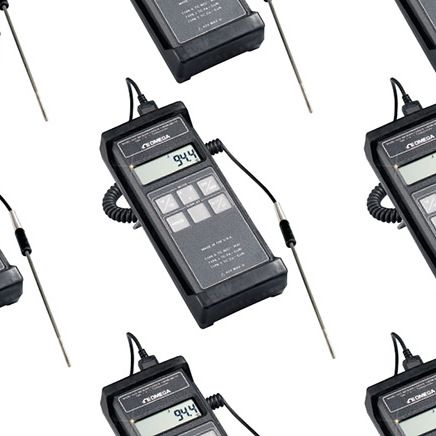A variable area flow meter(Figure 1) is a type of differential pressure (d/p) flow meter. Variable area flow meters are simple and versatile devices that operate at a relatively constant pressure drop and provide flow measurement of liquids, gases, and steam.
 Figure 1: A Number of Variable Area Flow Meter Designs
Figure 1: A Number of Variable Area Flow Meter Designs
The variable area flow meter is popular for industrial flow indication because it has a linear scale, a relatively long measurement range, and low pressure drop – and they are quite simple to install and maintain.
Variable area flow meters, like all other types of differential pressure flow meters, function on the principles of the Bernoulli equation, which states that as the flow of a fluid increases, pressure loss occurs.
How Variable Area Flow Meters Work
The position of the variable area flow meter’s in-line float, piston, or vane is changed as the increasing flow rate opens a larger flow area to pass the flowing fluid. The position of the float, piston, or vane provides a direct visual indication of flow rate. Design variations include the rotamer (a float in a tapered tube), orifice/rotameter combination (bypass rotameter), open-channel variable gate, tapered plug, and vane or piston designs.
Either the force of gravity or a spring is used to return the flow element to its resting position when the flow lessens. Gravity-operated meters (rotameters) must be installed in a vertical position, whereas spring operated ones can be mounted in any position. All variable area flow meters are available with local indicators. Most can also be provided with position sensors and transmitters (pneumatic, electronic, digital, or fiberoptic) for connecting to remote displays or controls.
Variable Area Flow Meter Principle of Operation
The variable area flow meter’s operation is based on the variable area principle: fluid flow raises a float in a tapered tube, increasing the area for passage of the fluid. The greater the flow, the higher the float is raised. The height of the float is directly proportional to the flow rate. With liquids, the float is raised by a combination of the buoyancy of the liquid and the velocity head of the fluid. With gas flow, buoyancy is negligible, and the float responds to the velocity head alone. The float moves up or down in the tube in proportion to the fluid flow rate and the annular area between the float and the tube wall. The float reaches a stable position in the tube when the upward force exerted by the flowing fluid equals the downward gravitational force exerted by the weight of the float. A change in flow rate upsets this balance of forces. The float then moves up or down, changing the annular area until it again reaches a position where the forces are in equilibrium. To satisfy the force equation, the variable area flow meter float assumes a distinct position for every constant flowrate. However, it is important to note that because the float position is gravity dependent, variable area flow meters must be vertically oriented and mounted.
Purge-Flow Regulators
If a needle valve is placed at the inlet or outlet of a rotameter, and a d/p regulator controls the pressure difference across this combination, the result is a purge-flow regulator. Such instrumentation packages are used as self-contained purge flow meters (Figure 2). These are among the most widely used flow meters and are low cost. Their main application is to control small gas or liquid purge streams. They are used to protect instruments from contacting hot and corrosive fluids, to protect pressure taps from plugging, to protect the cleanliness of optical devices, and to protect electrical devices from igniting upon contact with combustibles.
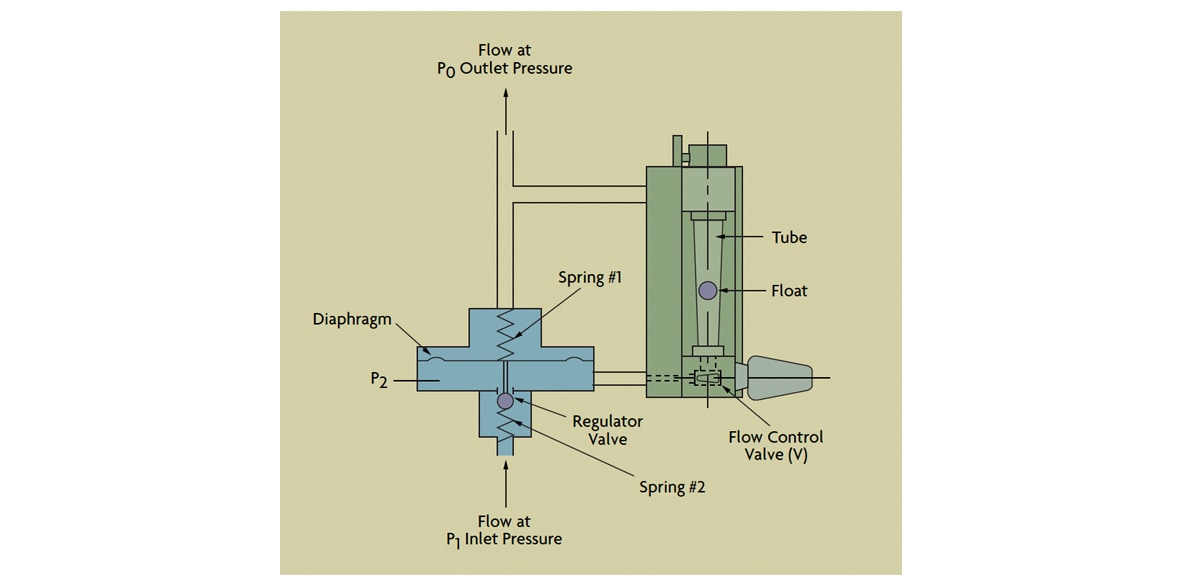 Figure 2: Purge Flow Meter Design
Figure 2: Purge Flow Meter Design
Purge meters are quite useful in adding nitrogen gas to the vapor spaces of tanks and other equipment. Purging with nitrogen gas reduces the possibility of developing a flammable mixture because it displaces flammable gases. The purge-flow regulator is reliable, intrinsically safe, and inexpensive.
As shown in Figure 2 purge meters can operate in the constant flow mode, where P2 – P0 is held constant at about 60 to 80 in H20 differential. In bubbler and purge applications, the inlet pressure (P1) is held constant, and the outlet pressure (P0) is variable. Figure 2 describes a configuration where the outlet pressure (P0) is held constant, and the inlet pressure (P1) is variable.
They can handle extremely small flow rates from 0.01 cc/min for liquids and from 0.5 cc/min for gases. The most common size is a glass tube rotameter with 1/4 in (6 mm) connections, a range of 0.05-0.5 gpm (0.2-2.0 lpm) on water or 0.2-2.0 scfm (0.3-3.0 cmph) in air service. Typical accuracy is ±5% FS over a 10:1 range, and the most common pressure rating is 150 psig (1 MPa).
Rotameters
The rotameter is the most widely used variable are flowmeter because of its lost cost, simplicity, low pressure drop, relatively wide rangeability, and linear output. Its operation is simple: in order to pass through the tapered tube, the fluid flow raises the float. The greater the flow, the higher the float is lifted. In liquid service, the float rises due to a combination of the buoyancy of the liquid and the velocity head of the fluid. With gases, buoyancy is negligible, and the float responds mostly to the velocity head.
In a rotameter (Figure 1), the metering tube is mounted vertically, with the small end at the bottom. The fluid to be measured enters at the bottom of the tube, passes upward around the float, and exits the top. When no flow exists, the float rests at the bottom. When fluid enters, the metering float begins to rise.
The float moves up and down in proportion to the fluid flow rate and the annular area between the float and the tube wall. As the float rises, the size of the annular opening increases. As this area increases, the differential pressure across the float decreases. The float reaches a stable position when the upward force exerted by the flowing fluid equals the weight of the float. Every float position corresponds to a particular flowrate for a particular fluid’s density and viscosity. For this reason, it is necessary to size the rotameter for each application. When sized correctly, the flow rate can be determined by matching the float position to a calibrated scale on the outside of the rotameter. Many rotameters come with a built-in valve for adjusting flow manually.
Several shapes of float are available for various applications. One early design had slots, which caused the float to spin for stabilizing and centering purposes. Because this float rotated, the term rotameter was coined.
Rotameters are typically provided with calibration data and a direct reading scale for air or water (or both). To size a rotameter for other services, one must first convert the actual flow to a standard flow. For liquids, this standard flow is the water equivalent in gpm; for gases, the standard flow is the air flow equivalent in standard cubic feet per minute (scfm). Tables listing standard water equivalent gpm and/or air scfm values are provided by rotameter manufacturers. Manufacturers also often provide side rules, nomographs, or computer software for rotameter sizing.
How to Select a Variable Area Flow Meter: Design Variations
A wide choice of materials is available for floats, packing, O-rings, and end fittings. Rotameter tubes for such safe applications as air or water can be made of glass, whereas, if breakage would create an unsafe condition, they are provided with metal tubes. Glass tubes are most common – being precision formed of safety shielded borosilicate glass. Floats typically are machined from glass, plastic, metal, or stainless steel for corrosion resistance. Other float materials include carboloy, sapphire, and tantalum. End fittings are available in metal or plastic. Some fluids attack the glass metering tube, such as wet stream or high-pH water over 194oF (which can soften glass); caustic soda (which dissolves glass); and hydrofluoric acid (which etches glass).
Floats have a sharp edge at the point where the reading should be observed on the tube-mounted scale. For improved reading accuracy, a glass-tube rotameter should be installed at eye level. The scale can be calibrated for direct reading of air or water or can read percentage of range. In general, glass tube rotameters can measure flows up toa bout 60 gpm water and 200 scfh air.
A correlation rotameter has a scale from which a reading is taken (Figure 1). This reading is then compared to a correlation table for a given gas or liquid to get the actual flow in engineering units. Correlation charts are readily available for nitrogen, oxygen, hydrogen, helium, argon, and carbon dioxide. While not nearly as convenient as a direct reading device, a correlation meter is more accurate. This is because a direct reading device is accurate for only one specific gas or liquid at a particular temperature and pressure. A correlation flow meter can be used with a wide variety of fluids and gases under various conditions. In the same tube, different flow rates can be handled by using different floats.
Small glass tube rotameters are suitable for working with pressures up to 500 psig, but the maximum operating pressure of a large (2-in diameter) tube may be as low as 100 psig. The practical temperature limit is about 400oF, but such high-temperature operation substantially reduces the operating pressure of the tube. In general, there is a linear relationship between operating temperature and pressure. Glass-tube rotameters are often used in applications where several streams of gases or liquids are being metered at the same time or mixed in a manifold, or where a single fluid is being exhausted through several channels (Figure 3). Multiple tube flow meters allow up to six rotameters to be mounted in the same frame.
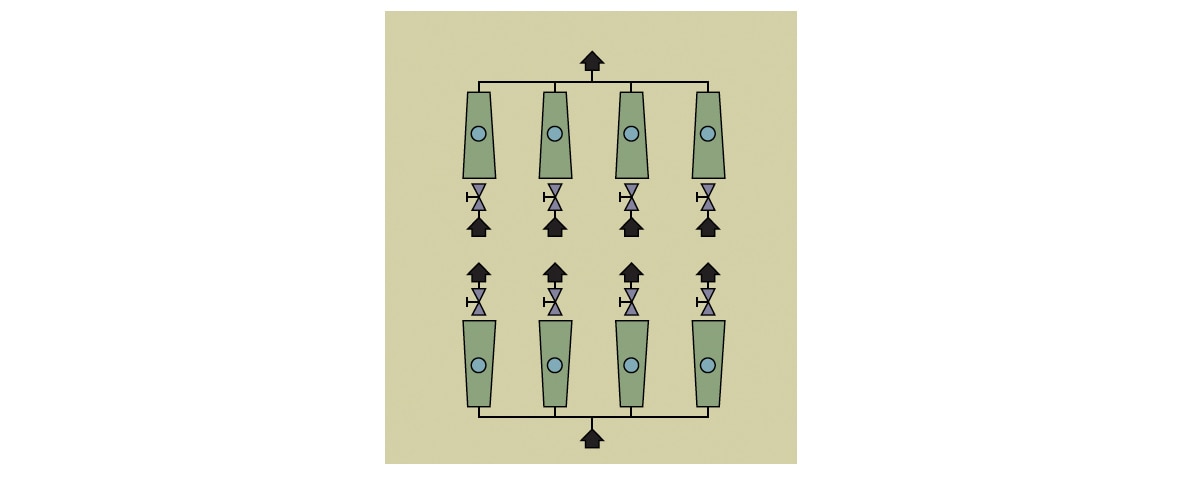 Figure 3: Multi-Tube Rotameter Station
Figure 3: Multi-Tube Rotameter Station
It also is possible to operate a rotameter in a vacuum. If the rotameter has a valve, it must be placed at the outlet at the top of the meter. For applications requiring a wide measurement range, a dual-ball rotameter can be used. This instrument has two ball floats: a light ball (typically black) for indicating low flows and a heavy ball (usually white) for indicating high flows. The black ball is read until it goes off scale, and then the white ball is read. One such instrument has a black measuring range from 235-2,350 ml/min and a white to 5,000 ml/min.
For higher pressures and temperatures beyond the practical range of glass, metal tube rotameters can be used. These tubes are usually made of stainless steel, and the position of the float is detected by magnetic followers with readouts outside the metering tube.
Metal-tube rotameters can be used for hot and strong alkalis, fluorine, hydrofluoric acid, hot water, steam, slurries, sour gas, additives, and molten metals. They also can be used in applications where high operating pressures, water hammer, or other forces could damage glass tubes. Metal-tube rotamers are available in diameter sizes from 3/8 in to 4 in, can operate at pressures up to 750 psig, temperatures to 540oC (1,000°F), and can measure flows up to 4,000 gpm of water of 1,300 scfm of air. Metal-tube rotameters are readily available as flow transmitters for integration with remote analog or digital controls. Transmitters usually detect the float position through magnetic coupling and are often provided with external indication through a rotatable magnetic helix that moves the pointer. The transmitter can be intrinsically safe, microprocessor-based, and can be provided with alarms and a pulse output for totalization.
Plastic-tube rotameters are low-cost rotameters that are ideal for applications involving corrosive fluids or deionized water.
Accuracy
Laboratory rotameters can be calibrated to an accuracy of 0.50% AR over a 4:1 range, while the inaccuracy of industrial rotamers is typically 1-2% FS over a 10:1 range. Purge and bypass rotameter errors are in the 5% range.
Rotameters can be used to manually set flow rates by adjusting the valve opening while observing the scale to establish the required process flow rate. If operating conditions remain unaltered, rotameters can be repeatable to within 0.25% of the actual flow rate.
Most rotameters are relatively insensitive to viscosity variations. The most sensitive are very small rotameters with ball floats, while larger rotameters are less sensitive to viscosity effects. The limitations of each design are published by the manufacturer (Figure 4). The float shape does affect the viscosity limit. If the viscosity limit is exceeded, the indicated flow must be corrected for viscosity.
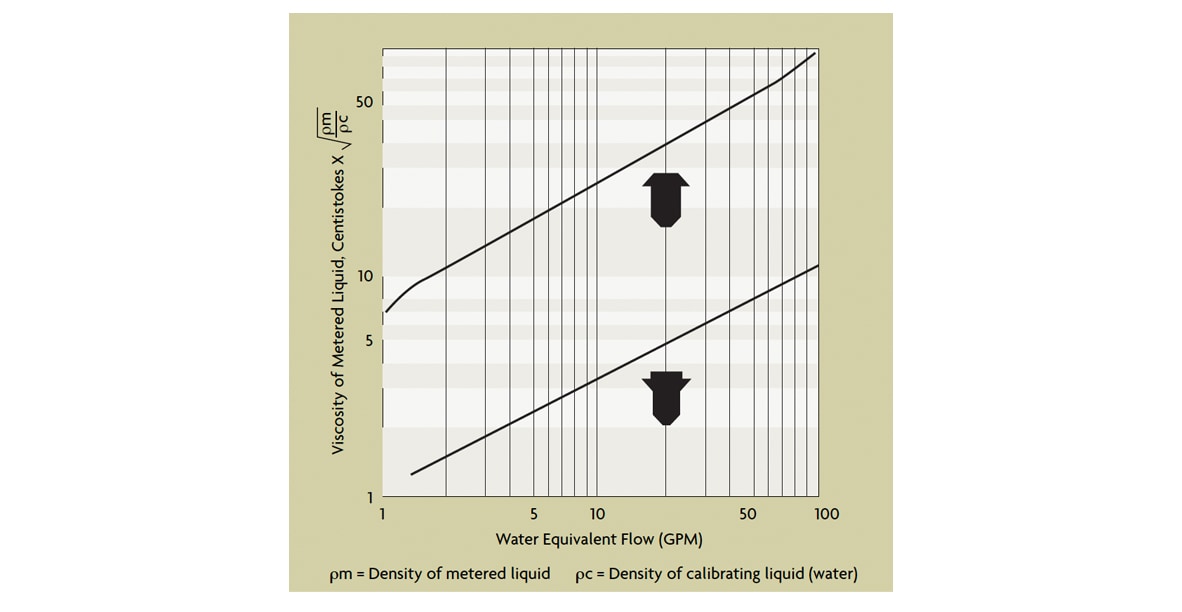 Figure 4: Rotameter Maximum Velocity
Figure 4: Rotameter Maximum Velocity
Because the float is sensitive to changes in fluid density, a rotameter can be furnished with two floats (one sensitive to density, the other to velocity) and used to approximate the mass flow rate. The more closely the float density matches the fluid density, the greater the effect of a fluid density change will be on the float position. Mass-flow rotameters work best with low viscosity fluids such as raw sugar juice, gasoline, jet fuel, and light hydrocarbons.
Rotameter accuracy is not affected by the upstream piping configuration. The meter also can be installed directly after a pipe elbow without adverse effect on metering accuracy. Rotameters are inherently self-cleaning because, as the fluid flows between the tube wall and the float, it produces a scouring action that tends to prevent the buildup of foreign matter. Nevertheless, rotameters should be used only on clean fluids which do not coat the float or the tube. Liquids with fibrous materials, abrasives, and large particles should also be avoided.
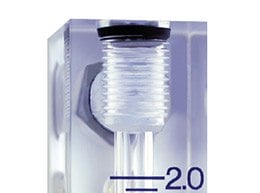
Omega Variable Area Flow Meters
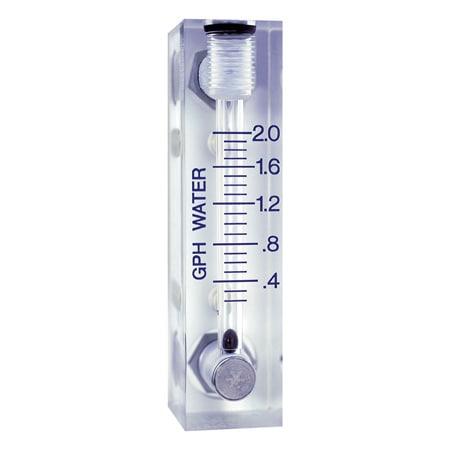
Glass Tube Variable Flow Meters
The basic variable area flow meter is the glass tube indicating type. The tube is precision formed of borosilicate glass, and the float is precisely machined from metal, glass, or plastic. The scale of the meter can be calibrated for direct reading of air or water, or it may have a scale to read a percent of range or an arbitrary scale to be used with conversion equations or charts. Safety-shielded glass tube variable area flow meters are in general use throughout industry for measuring both liquids and gases.
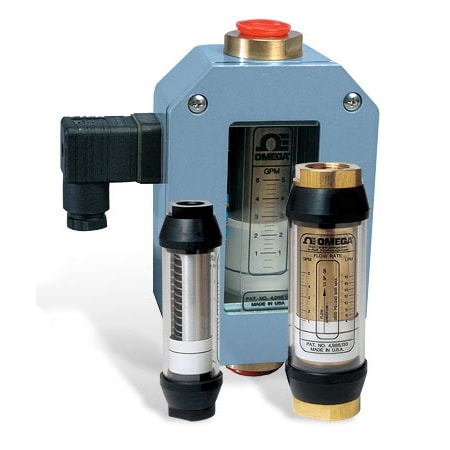
Metal Tube Flow Meters
Metal tube flow meters are used for services where high operating pressure, a high temperature range, water hammer, or other forces would damage glass metering tubes. Metal tube flow meters can be used for most fluids, including corrosive liquids and gases. They are particularly well suited for steam applications, where glass tubes are unacceptable.
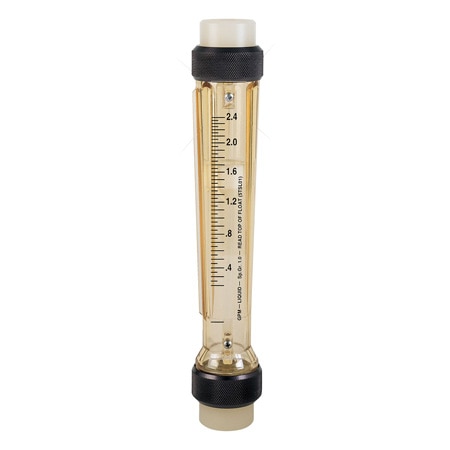
Plastic Tube Variable Flow Meters
Plastic tubes are used in some variable area flow meter designs due to their lower cost and high impact strength. They are typically constructed of polycarbonate, with either metal or plastic end fittings. With plastic end fittings, care must be taken in installation to not distort the threads. Meters with all plastic construction are available for applications where metal wetted parts cannot be tolerated, such as with deionized water or corrosives.
Other Variable Area Flow Meter Types
Major disadvantages of the rotameter are its relatively high cost in larger sizes and the requirement that it be installed vertically (there may not be enough head room). The cost of a large rotameter installation can be reduced by using an orifice bypass or a pitot tube in combination with a smaller rotameter. The same-size bypass rotameter can be used to measure a variety of flows, with the only difference between applications being the orifice plate and the differential it produces.
Advantages of a bypass rotameter include low cost; its major disadvantage is inaccuracy and sensitivity to material build-up. Bypass rotameters are often provided with isolation valves so that they can be removed for maintenance without shutting down the process line.
Tapered plug flow meters are variable area flow meters with a stationary core and a piston that moves as the flow varies. In one design, the piston movement mechanically moves a pointer, while in another it magnetically moves an external flow rate indicator. The second design has a metallic meter body for applications up to 1,000 psig.
One gate-type variable-area flow meter resembles a butterfly valve. Flow through the meter forces a spring-loaded vane to rotate, and a mechanical connection provides local flow rate indication. The inaccuracy of such meters is 2-5% FS. The meter can be used on oil, water, and air, and is available in sizes up to 4 inches. It also is used as an indicating flow switch in safety interlock systems.
